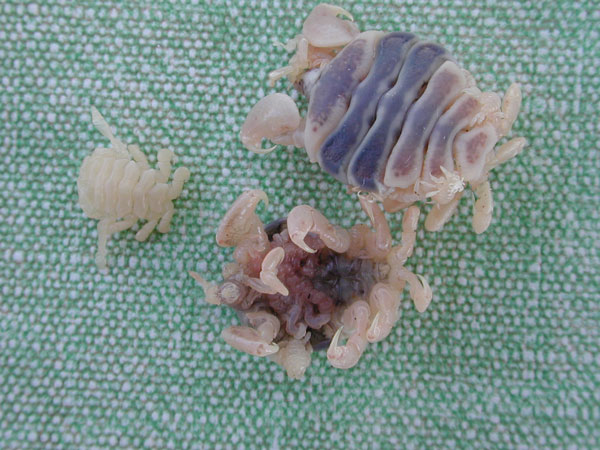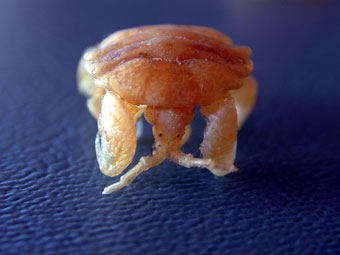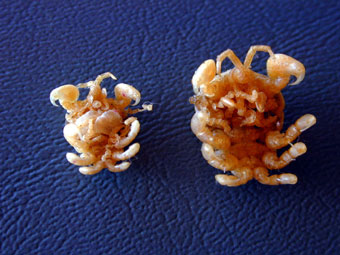The Migration South
Spyhoping, breaching and fluking are behaviors of the gray whale. (GA images) |
| Traveling south along the coast of western North America, the gray whale is often seen during the fall singly or in small groups of 2-10. The pregnant females are the first to migrate, followed by the non-pregnant females and then the males. This 6-7,000 mile trip usually takes the whales about three months. They average 60-100 miles a day, traveling at a speed of 4 knots for a 15-20 hour day however, gray whales have been clocked at 10 knots. Along the way the whales can be seen "spyhopping", a behavior thought to be their way of looking at landmarks that they may use to remember their migratory route. Although not known for jumping out of the water (breaching) or flipping its tail in the air when diving (fluking), the gray whale does exhibit both of these cetacean behaviors on occasion. |
Barnacles and lice can be seen on the back of this gray whale. (GA image) |
| Whale barnacles and whale lice are common ectoparasites (external parasites) on gray whales. The gray whale has a large amount of the surface area of its skin covered with patches of these ectoparasites. The barnacles and lice are not really parasites because they are not actually hurting the whale. Many people think that the gray whale does not really "feel" these, although a few people believe that gray whales try to rub them off on the bottom of the ocean because they bother them. |
The gray whale barnacle grows on the skin of the gray whale. It pushes the black skin apart as it grows, reaching adult size (about 5cm) in one year. Notice the single whale louse to the upper left of the barnacle. (Image, with permission, from Western Marine Lab) |
| The most conspicuous ectoparasite is the barnacle Cryptolepas rhachianecti. This species of barnacle is found only on gray whale skin. The barnacle itself is a filter feeder, sticking its feathery legs out of its shells and gathering microscopic plankton from the water. These whale barnacles use the whale as a substrate for attachment and the current of water passing over the whale to bring them lots of plankton. It does not have to expend a lot of energy filtering the water because the whale provides all the movement. (Most barnacles attached to solid substrates must expend a lot of energy kicking their legs in and out to get enough plankton to survive.) |
This photomicrograph of the cyprid stage of the gray whale barnacle shows a tiny leg protruding from one end. It is believed that this leg is used by the planktonic cyprid to first attach to the gray whale skin. (SA image) |
| The whale barnacles have microscopic planktonic larvae similar to all other barnacles. The cyprid stage of these planktonic larvae attaches to whale skin and imbeds its body in the skin. As it grows its volcano-shaped shell, it keeps a low profile (to avoid being torn off in the current of water passing over the whale's skin) and pushes the whale skin apart. This species grows to full size (1 to 1 1/2 inches across) in about a year. All whales with full sized barnacles are at least one year old. It is believed that the barnacles reproduce and release their planktonic larvae only in the lagoons in Baja because tiny, newly settled barnacles can be found on the baby gray whales and the parents only while in the Baja lagoons. The presence of tiny, newly settled barnacles can be used as an indication that a whale had been to Baja that year. After a year all the whale barnacles are the same size no matter how many years old they are. A whale with adult barnacles and newly settled ones is at least a year old and has been to the Baja lagoons recently. |
 |
The most common whale lice are the cyamid amphipods with curly gills shown here. (GA image) |
Whale lice are really unique amphipod crustaceans. They have flattened bodies and sharp hooks on the tips of their legs. They hang onto the whale skin with these hooks and tend to cluster on the barnacle patches, folds in the whale's skin, and on any wound. These lice are cyamid amphipods and occur on several species of whales, not just the gray whale. Three species of cyamid amphipods occur on the gray whale. Cyamus scammoni is the largest and most abundant. It can be distinguished from the other two species because it has curly gills on its underside. The other two species have straight gills. Cyamid amphipods are scavengers and will eat anything. Their most common food on the gray whale is the flaking skin found where the barnacles are growing and on a wound. They appear to clean up dead skin rather than cause any irritation. Since the cyamid amphipods are motile (and not imbedded in the flesh like the barnacles) they are probably transferred between the whales as they touch.
|
  |
Cyamus scammoni head (left). On the right is a ventral image of two Cyamus scammoni adults, a female on the left showing marsupium, and a male on the right showing the curly gills. (GA images) |
Cyamus kessleri on the left, is a whale louse that has straight gills (the extensions coming forward in front of its head) most often found in the cracks of a whale's skin. This one was taken from the genital area. The middle two whale lice are Cyamus scammoni males showing the bottom view and top view respectively. The whale louse on the right is a female Cyamus scammoni. (GA image) |
Whale lice have unique life cycles for a marine crustacean. Most marine crustaceans have a microscopic planktonic larval stage that drifts in the ocean (like the whale barnacles). Whale lice females brood their young in a pouch-like structure, called the marsupium, on the underside (ventral) of their bodies. The babies develop here and then crawl away. This assures the baby whale lice of their natural surface (whale skin). Since baby gray whales are born free of any ectoparasites (barnacles and lice) it is believed they get their lice from touching (nursing) their mother. In Cyamus scammoni there is sexual dimorphism with the adults, not only with the presence or absence of the marsupium but with their size. The female Cyamus scammoni lice rarely get over a half inch in length whereas males can be over an inch long.
|
|

